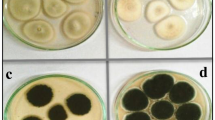Abstract
The aim of this investigation was to find the optimal working conditions for the chemical treatment of molasses that guarantee coagulation and precipitation of undesired macromolecules. Twenty experiments were performed, within the limits: 3.5≤pH≤8.5 and 0.1 mol Al/l≤c≤0.5 mol Al/l, on samples of molasses treated with Al2(SO4)3 as a precipitant. The efficiency of the treatment was controlled through measuring both the zeta potential and solution absorbance at 560 nm. By analysing the experimental results, it was concluded that the optimum lies within reduced limits of: 4≤pH≤7 and 0.2 mol Al/l≤c≤0.4 mol Al/l, which covers nine experimental points. Based on these measurements, a mathematical model of absorbance changes was defined, in terms of pH and Al2(SO4)3 quantity. The model was taken as the objective function, and the optimal calculated values were obtained: pH=5.3 and c=0.34 mol Al/l. They guarantee a minimal absorbance value of: 0.124 at 560 nm.



Similar content being viewed by others
Abbreviations
- A :
-
Absorbance at 560 nm
- b :
-
Parameters in the regression
- c=x2:
-
Concentration of aluminium sulphate in a solution
- δ :
-
Deviation between calculated and measured values
- n :
-
Number of measurements
- t :
-
Measure of parameter significance
- x 1 :
-
pH value of a solution
- ZP :
-
Zeta potential
References
Junghans E (1980) Die Zuckerherstellung. VEB Fachbuchverlag, Leipzig
Duan J, Gregory J (2003) Adv Colloid Interface Sci 100–102:475–502
Wawro S (1994) Gaz Cukrow 102:22–224
Stephenson RJ, Duff SJB (1996) Water Res 30:781–792
Cathalifaud G, Ayele J, Mazet M (1997) Water Res 31:689–698
Pinotti A, Zaritzky N (2001) Waste Manage 21:535–542
Duan J, Wang J, Graham N, Wilson F (2002) Desalination 150:1–14
Aguilar MI, Sáez J, Lloréns M, Soler A, Ortuño JF (2002) Water Res 36:2910–2919
Tatsi AA, Zouboulis A , Matis KA, Samaras P (2003) Chemosphere 53:737–744
Őzacar M, Şengil ÌA (2003) J Hazard Mater B100:131–146
Erricson PO, Tjebes J (1978) 17th Session ICUMSA, pp. 131–162. Montreal
Mauch W (1990) 20th Session ICUMSA, Colorado Springs, pp. 79–91
Lević LJ, Gyura J (1999) Nahrung 43:S288–S289
Reinfeld E, Schreider F (1978) Analytische Betriebskotrolle der Zuckerindustrie. Verlag Dr. Albert Bartens, Berlin
Aknowledgement
The Ministry of Science, Technology and Development of Serbia (Project No 1362) financially supported this work.
Author information
Authors and Affiliations
Corresponding author
Rights and permissions
About this article
Cite this article
Lević, L., Gyura, J., Djurić, M. et al. Optimization of pH value and aluminium sulphate quantity in the chemical treatment of molasses. Eur Food Res Technol 220, 70–73 (2005). https://doi.org/10.1007/s00217-004-1017-z
Received:
Published:
Issue Date:
DOI: https://doi.org/10.1007/s00217-004-1017-z




